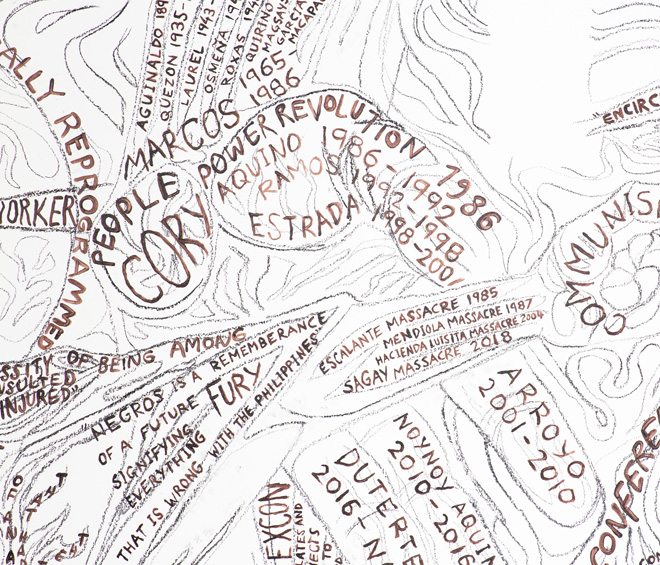
Amy Lien and Enzo Camacho. Lecture notes on Alfonso Ossorio's Angry Christ mural at the Victorias Milling Company Complex in Negros Occidental, Philippines, 1950, 2018 (detail).
Brunei Gallery, Soas University of London
12 April – 22 June 2019
by HARRIET THORPE
The Philippines is an archipelago of more than 7,000 islands where more than 150 languages are spoken. Its capital is Manila. It was colonised by the Spanish in the 16th century, until American and then Japanese powers took over in the 20th century. The country gained independence in 1946, and from 1965 to 1986 Ferdinand Marcos led a dictatorship. What else do you know about the Philippines? Or, more interestingly, how do you know it, and who told you? The last two questions are the ones that Motions of This Kind: Propositions and Problems of Belatedness, at the Brunei Gallery at the School of Oriental and African Studies in London, is most interested in.
The curators found it funny that the Philippines was a bit of a mystery to Isaac Newton. Newton wrote about his bewilderment at “Leuconia” (the Ptolemaic name for Luzon, the largest island in the archipelago) being at the centre of a strange tidal delay detected by Edmund Halley in the 17th century. Filipino scholar Ricardo Manapat, writing in 2011, referred to how, as well as this scientific lacuna, there was also a cultural one – a delay in knowledge and ideas from the Philippines. This inspired Merv Espina, an artist and researcher based in Quezon City, Renan Laru-an, a researcher and co-ordinator at the Philippine Contemporary Art Network, and Rafael Schacter, a teaching fellow at University College London and an anthropologist and author, to put together an exhibition.
Rather than an exhibition, though, Motions of This Kind is more of a methodology. Eleven artists each provide a unique frame for seeing the Philippines. Their work often starts with a personal history, although it is rarely chronological, and they sometimes weave truth with fiction and always complicate things with warmth, humour or anger. It is a methodology that is critical of the colonial “frame” imposed by archives, museums, objects and other people who controlled, and control, how the Philippines is perceived across the world. For example, the methodology questions the relationship between “speed” and “progress” imposed by colonial powers as parallel. And in a world where fast food, fast fashion and fast cars have brought so many problems, it suggests that perhaps a slow internet connection could bring us some time to think, and a 108-year-late carnival arrived just on time.
-(2018).jpg)
Cian Dayrit, YUTA NAGI PANAAD (Promised Land), 2018. Embroidery on fabric, objects, 183 x 260 cm.
Turning what we thought we knew upside-down is artist Cian Dayrit, who flips the north-south axis of a colonial map from 1744, replacing colonial place names with indigenous ones. His tapestry, Northern Conquests in Oriental Soil and Sea, is an act of “counter cartography” embroidered with meaning, displayed alongside a vitrine of early-20th-century archival objects interspersed with common tourist knick-knacks.
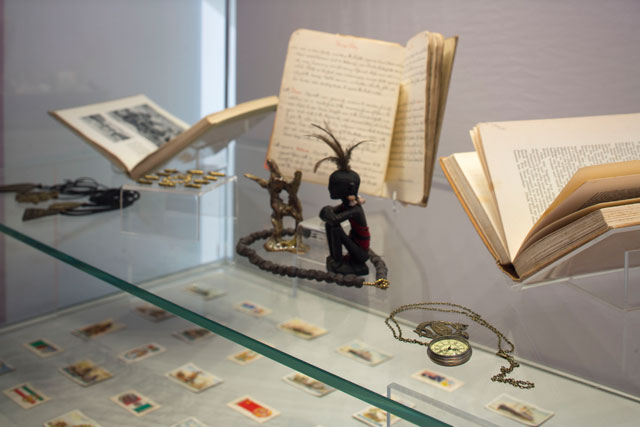
Cian Dayrit, Northern Conquests in Oriental Soil and Sea (detail), 2019. Tapestry, archival objects and documents arranged in museum vitrine.
Like the maps we trust to guide us in the right direction, we also have an expectation that museums – with their edited selections of objects – should tell us the truth. Yet the museum is where power met material culture, and they are still very much together. Motions of This Kind protests against the etiquette of the museum. It wraps, overtakes and invades, escaping the boundaries of display – photography is printed across the walls, a mural flows over two levels, a table of drawings and colouring pencils breaks the fourth wall, and waves of sound, light and an internet network radiate less conspicuously.
In the archival Foyle Gallery, a room full of vitrines adjoining the exhibition space, academics Cristina Juan, lead programmer for Philippine Studies at Soas University of London, and Delphine Mercier, curator of the ethnographic collection at UCL Anthropology, have created a “para-curatorial display” using objects from the SOAS Ifor B Powell archive (a collection of 150 boxes of material from a Welsh academic active in the Philippines in the mid-20th century). The pair assemble evidence of an “informal empire” of various British “entanglements” in the Philippines during the colonial period. The display is an exercise in reading between the lines, retracing footsteps and understanding why things add up the way they do.
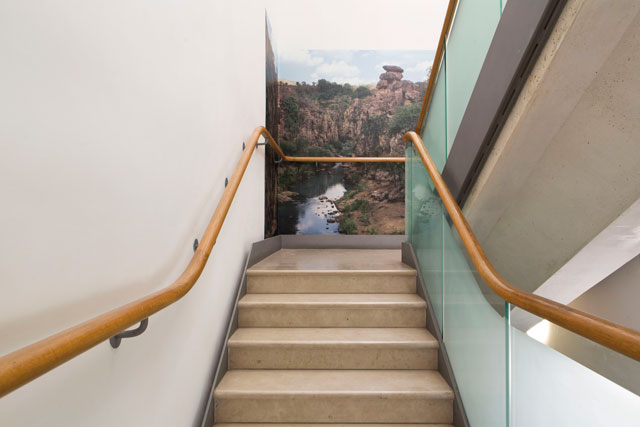
Lizza May David & Gabriel Rossell-Santillán, How many seas will you swim? 2019. Wallpaper, 26 ft x 36 in.
There are also some unexpected objects here, too. Schachter says: “Three of our artists have crept into the archive to corrupt it.” Manila-born Kat Medina’s wooden frames woven with rope, glass beads and oil paint trail and stretch colour across the gallery like climbing plants across ancient ruins. Meanwhile, a small gold leaf from a Bauhinia orchid tree that stands alone inside the central vitrine is the work of artists Lizza May David and Gabriel Rossell Santillán, who use the plant as a way to trace the shared colonial histories of the Philippines and Mexico.
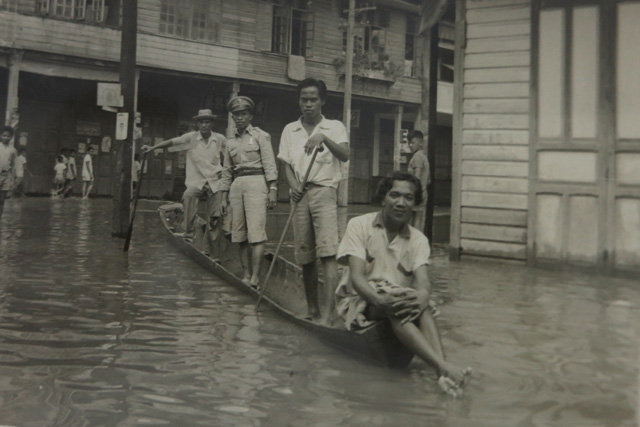
Michelle Dizon,The Archive’s Fold, Flood in Cotabato, Mindanao, date unknown.
Michelle Dizon’s frame is her own family – with a sci-fi twist; she imagines a fictional exchange of letters between her great-great-great-grandmother, Latipa, in 1905, and her great-great-great-granddaughter in 2123. Inspired by a family legend that the elder Latipa was magical, and her own experience of growing up in Los Angeles with her Filipino parents, she began to explore the depths of the US colonial archives. “I found myself in America’s heart of darkness, made visual and brought into being through photographs,” she says. Her collage of photographic slides, accompanied by the whir of 11 projectors softly clicking, is combined with photographs from Filipino archives and the archives of the women of her family. She questions “the unstoppable development of images, the corruption, fading and folding of images” and seeks to reframe history through a personal and feminist lens.
Schacter says: “Dizon is interested in both trauma and love, and how the archive needs to be resurrected, how it should die, how it can be cropped to present ideas, or back up forms of power.” Most of the artists, he says, are “happy to intertwine the familial with these larger colonial ideas. Anthropology has a more avant-garde side in autoethnography. We were taught always in secondary school never to use ‘I’ – that is the most ridiculous thing.”
The complexities of family history found in the exhibition are wide. Jon Cuyson’s own story is at the centre of Dancing the Shrimp (whodoyouthinkyouare?), 2019, his colourful 360-degree tableaux of objects including shrimp shells, AK47s, oyster sauce, Coca-Cola bottles and archival photographs that chart economic exchange between the US and the Philippines. He traces his ancestry to links with one of the American military personnel who were stationed at the (now repurposed) US military base in Pampanga, where he grew up. When it comes to trade, economy and labour, humans are much more complex than objects.
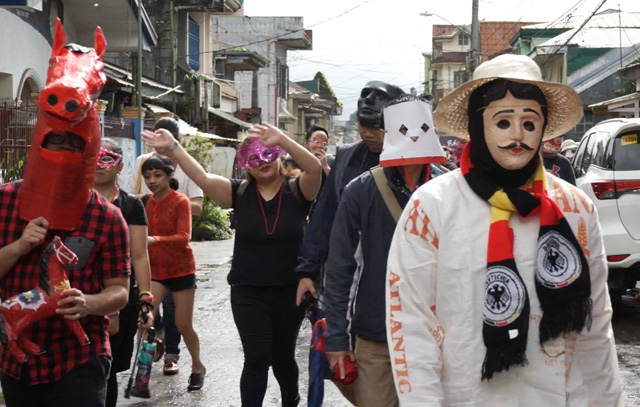
Mark Salvatus, Ensayo, 2019. Film still.
Mark Salvatus, too, returned to his home town, Lucban in the province of Quezon, in 2018 to restage a carnival that, according to a newspaper article he found in Manila’s Lopez Museum archives, was held on 31 December 1910. Photographs showed an event filled with global references – conquistador-style masks, Catholic pageants and secular parades – the article claimed it would return every year, yet no one in Lucban today has heard of it. Schacter says: “It held within it both a strange mystical history, but also linked his home town to these global themes.” While the second carnival arrived 108 years late, its timing could not have been more appropriate for Salvatus to be able to reclaim his own history and culture in an era of postcolonial discourse.
While some stories, objects and images have been shrouded by more powerful histories, ignored, or forgotten, sometimes, like Halley’s tidal pulls from space or Newton’s lacuna of knowledge, they are also invisible. The exhibition plays with other types of motions – light waves, sound waves and wifi networks – all travelling at different speeds through the exhibition with assorted urgency.
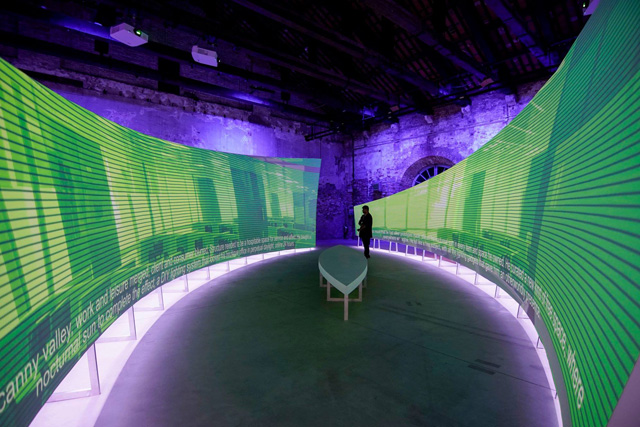
Yason Banal, Untitled Formation, Concrete Supernatural, Pixel Unbound. Video installation, dimensions variable, 2018 YBAVB11.
Yason Banal has set up a wifi network, slowed down to 69Kbps, very close to the actual wifi speed experienced by those using mobile phones in Manila (the average internet speed in the Philippines is reportedly the slowest in south-east Asia). This is so slow that a YouTube video from Banal’s curated series exploring topics of surveillance, censorship, spectacle and state power, does not load properly. If something is invisible and no one tells us about it, we do not think it could be there. Banal’s architectural model of the Manila Film Center, a building inaugurated in 1982 under the Marcos regime, doesn’t show the bodies of the labourers buried in its cement foundations after a fatal accident during its construction.
Schacter says that Banal is “obsessed” with the spinning wheel, the buffering symbol we see daily on our computer screens. Used across his work, and seen on the wall of the exhibition, the symbol is connected to time, waiting and loading. While irritating for most, Banal questions the positives of this moment in time that could be used for something else, how it slows us down to think clearly, or for the negative information that it shields us from – for example, Schacter explains how south-east Asia has a low consumption of internet porn because of the slow internet speed. Banal rethinks how belatedness can be addressed.
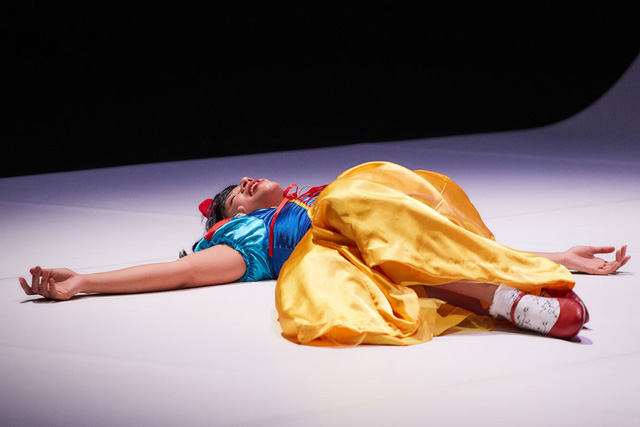
Eisa Jocson. Princess Image by Jörg Baumann.
The invisible network, accompanies the exhibition like a cloud, as do the high-pitched intermittent sounds of Eisa Jocson’s video Becoming White. Happy or melancholic, the tweets of little Disney birds and the feminine sighs of Snow White going about her household tasks are sung by two dancers, Jocson and her collaborator Joshua Serafin. Her repetitive choreography of domestic duties is a critique of the performance industry at Disneyland Hong Kong, where trained Filipino performers are employed; Snow White is seen as a “white” character, yet the irony lies in how the domestic jobs in Hong Kong are often filled by Filipino workers.
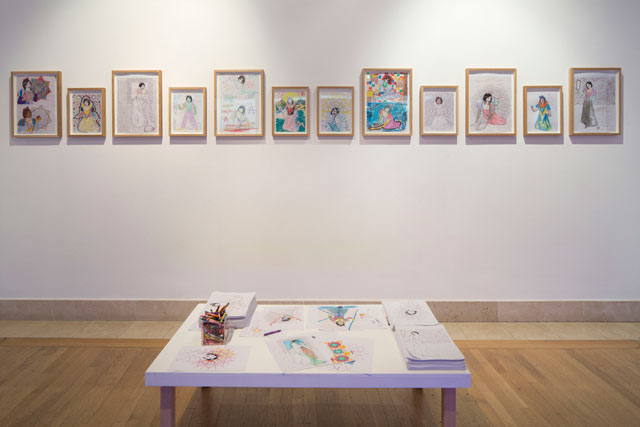
Background: Eisa Jocson, Colouring White, 2018. Framed A4 and A3 coloured copies from Manila and Shanghai. Foreground: Colouring White, 2019. Photocopies for the audience to take and colour. Produced for Cultural Center of the Philippines’ 13 Artists Awards 2018 and Bangkok Art Biennale 2018.
Jocson’s participatory colouring activity series Colouring White invites visitors to the exhibition to pick up a coloured pencil to colour in an image of Snow White, and express themselves – which they often do in anger.
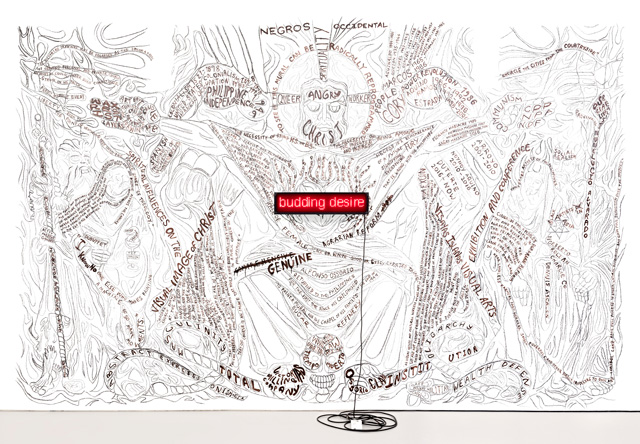
Amy Lien and Enzo Camacho. Lecture notes on Alfonso Ossorio's Angry Christ mural at the Victorias Milling Company Complex in Negros Occidental, Philippines, 1950, 2018.
Anger is an emotion that surges up through the exhibition, rising up the stairwell to the second floor of the gallery via Amy Lien and Enzo Camacho’s mural, Notes on The Angry Christ. Thin lines of charcoal and blood (imitation and real) depicting flames, snakes and faces lick the walls. Impulsive lines of text bubble; dates, facts and injustices, and, through the flames, the face of Christ emerges. It is a tribute to The Angry Christ, a mural by Alfonso Ossorio from 1950, commissioned for a modernist workers’ chapel on the sugar plantation owned by his family in Negros, the prime sugar-making facility of the Philippines.
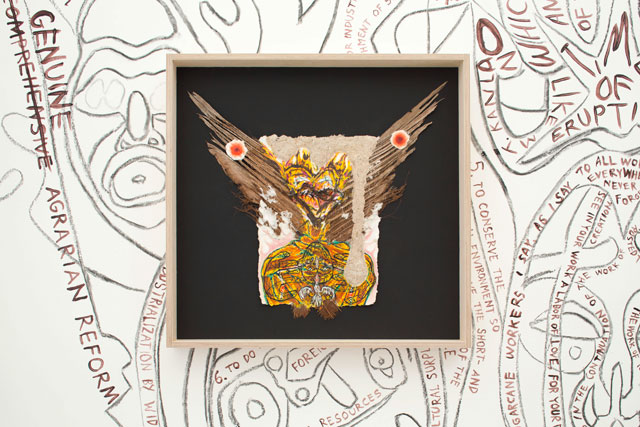
Amy Lien & Enzo Camacho, Notes on The Angry Christ (detail), 2019.
Charcoal, real/imitation blood, molasses, semen and soil. Dimensions variable.
Ossorio’s mural depicts the Last Judgment, unhinged and subjective. Christ is on fire with muscular definition, passion, the white heat of his blue robe and the hands of God. Ossorio drew with hard-edged lines and graphic shapes of block colour using wax and ink – a process of “absence rather than presence”, note the artists.
Yet the mural seems out of place in the Chapel of Saint Joseph, where mass services are held for workers at 5.45am on working days and 7.30am on Sundays. Lien and Camacho describe the mural as a “glitch”. Jean Dubuffet once described it as “a machine of many movements”, say the artists. Within it is a history embedded with violence, civil war, religion, protest, famine, labour and Ossorio’s queerness, energy and anger. The commission brought him back to the Philippines for the first time since he was a child, and he never returned again after he completed it. Subjectivity seems impossible to separate from history.
Schacter sees Notes on “The Angry Christ” as a research project in material form – a multidimensional project of interweaving histories of modernism, queerness, modernism, Catholicism and communism, in which layers of materials – molasses, semen, soil, candle wax, sugarcane flowers, birds’ nests and palm husks – are made into a piece of abstract art.
“I don’t see them as art,” says Schacter of the works in the exhibition. “For me, they are research projects and the output of them is formal, not necessarily written.” So, if the archive is the problem, then it is also the solution, and it is the methodology that holds the power. “Not denying the subjectivity in everyone’s research, starting with the personal, enables them to enter into these histories in a more tangible or visceral way.” While the exhibition began with motions – waves, forces and memories – it establishes a space that material culture can reclaim.